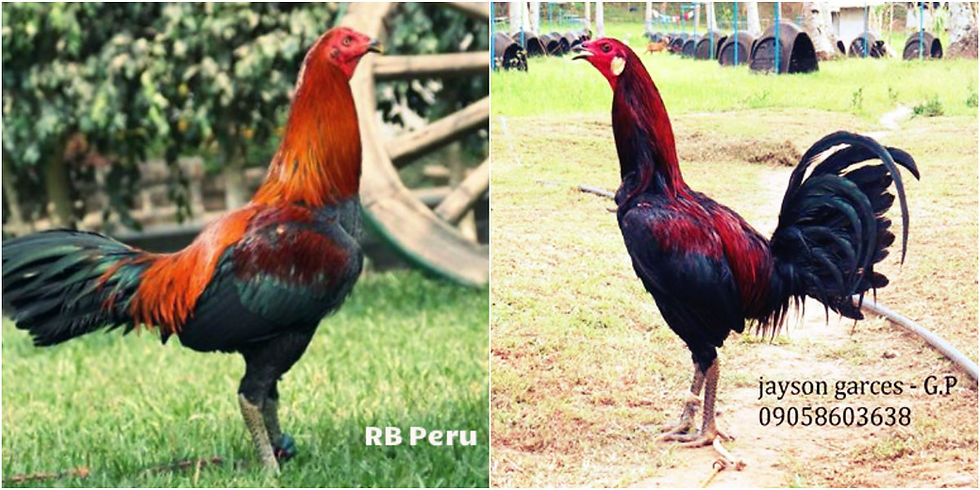Champion breeder talks why Peruvian Navajeros do not look all alike
- Raul Roy Bajenting
- Aug 13, 2015
- 3 min read

Rafael Bazan is a champion breeder of Peruvian Navajeros, having won grand championships in Peru twice. He will be sharing readers his thought and experiences regarding the Peruvian Navajeros.
Here’s Rafael Bazan’s question’s and answers interview with Roosterman E-Mag on some backgrounder on the Peruvian:
Roosterman: Mr. Bazan thank you for granting us this interview. Would you first say something about you and your illustrious career in breeding and fighting Peruvian Navajeros.
Thank you for the opportunity to introduce myself to the gamecock breeders and lovers in the Philippines. My love for fighting roosters started when I was 13 years old. I had an uncle who raised these birds and I fell in love with them from the moment I laid eyes on them. A few years later I had the chance to meet and get to know some well-known breeders such as Mr. Aurelio Gonzales Vigil, Javier Garcia, Cesar Flores, among others. From these breeders I learned how to create my own bloodline with the characteristics that I desired that even to this day has given me much satisfaction. I am a member of the Peruvian Knife Fighting Rooster Breeders Association (Asociación de criadores de gallos de pelea a navaja del Peru) and Circulo Gallístico of Peru; two of the most prestigious institutions of Peru. I was champion of the Peruvian Knife Fighting Rooster Breeders Association in 2003 and 2004 and have come in 4th place in 2005 and 3rd place in 2013. In the Circulo Gallístico I obtained 3rd place in 1994 and in several other championships I have won different places. All this I have accomplished in my 29 years of breeding.
Are the accounts about the Peruvian Game fowl coming from Spanish, Belgian, Oriental, English Game and other different breeds true? Is there anything you can add about the origin of the Peruvian Gamefowl?
The accounts are true and it is the reason why we are able to notice some differences among Peruvian roosters, such as some which favor Oriental characteristics and others Bankivoides. Since many decades ago up until now many well-known breeders have dedicated to make new crosses with American roosters, roosters from Chile and England, etc. so as to search a way of adding specific characteristics to the bloodline.
According to accounts, the Peruvian game fowl evolved into two types, the big ones which is used for long knife fighting which is the Navajero and the smaller ones, the type used for another kind of fighting. Which of the two types of fighting is the more popular in Peru?
Both are very popular at the national level, in the case of the piqueros (postiza game fowl) they are more widely used in international competitions, due to the fact that this type of rooster fights in many different countries such as Puerto Rico, Spain, Santo Domingo, Chile, Columbia, Ecuador, etc.
Cockfighting is legal in Peru. Right? How frequent are fights held in Peru?
Yes, cockfighting is legal in Peru and it is part of our tradition. The season starts in May and runs through to December with fights every weekend. In summer the roosters start molting and so ends the season.
In which places/cities in Peru that big cockfight events are held? Can you name the top Navajero events in Peru? And, where they are held and how frequent?
We can say that the most important fights are held in the capital Lima, Peru. The most important fights are the Santa Rosa of Lima which is held in August through November and organized by the Peruvian Knife Fighting Rooster Breeders Association; Traditional Championship which is organized by Circulo Gallístico and held May through October; Cotejo de Criadores (derby type system) held from June to August; Confraternidad Cañete held from July to December.
What are the different types of fighting navajeros in Peru and how do you call them, derby? Torneo? Hacks?
The Peruvian navajeros usually are torneos although the Cotejo de Criadores uses an American derby type system.
What is the regular breeding season in Peru? From what month to what month? When is the fighting season? When is molting season?
The regular breeding season is from June until November. The fighting season is from May to December. Molting season starts in December and ends in April.
Can you please add anything about the navajeros?
Yes, the Peruvian navajero for tradition is presented in a pit with its body covered with a small blanket and later are presented or shown to the public one in front of the other with their leashes. During this time the people make their bets. Then they are armed and let loose for the fight.
























Comments